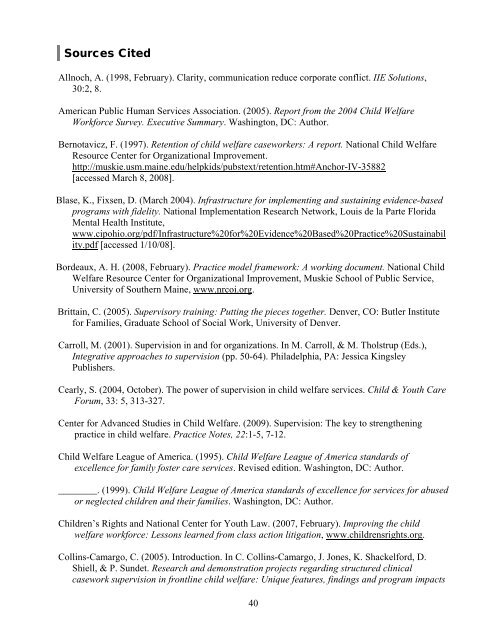Building a Model and Framework for Child Welfare Supervision
Building a Model and Framework for Child Welfare Supervision
Building a Model and Framework for Child Welfare Supervision
- No tags were found...
Create successful ePaper yourself
Turn your PDF publications into a flip-book with our unique Google optimized e-Paper software.
Sources CitedAllnoch, A. (1998, February). Clarity, communication reduce corporate conflict. IIE Solutions,30:2, 8.American Public Human Services Association. (2005). Report from the 2004 <strong>Child</strong> <strong>Welfare</strong>Work<strong>for</strong>ce Survey. Executive Summary. Washington, DC: Author.Bernotavicz, F. (1997). Retention of child welfare caseworkers: A report. National <strong>Child</strong> <strong>Welfare</strong>Resource Center <strong>for</strong> Organizational Improvement.http://muskie.usm.maine.edu/helpkids/pubstext/retention.htm#Anchor-IV-35882[accessed March 8, 2008].Blase, K., Fixsen, D. (March 2004). Infrastructure <strong>for</strong> implementing <strong>and</strong> sustaining evidence-basedprograms with fidelity. National Implementation Research Network, Louis de la Parte FloridaMental Health Institute,www.cipohio.org/pdf/Infrastructure%20<strong>for</strong>%20Evidence%20Based%20Practice%20Sustainability.pdf [accessed 1/10/08].Bordeaux, A. H. (2008, February). Practice model framework: A working document. National <strong>Child</strong><strong>Welfare</strong> Resource Center <strong>for</strong> Organizational Improvement, Muskie School of Public Service,University of Southern Maine, www.nrcoi.org.Brittain, C. (2005). Supervisory training: Putting the pieces together. Denver, CO: Butler Institute<strong>for</strong> Families, Graduate School of Social Work, University of Denver.Carroll, M. (2001). <strong>Supervision</strong> in <strong>and</strong> <strong>for</strong> organizations. In M. Carroll, & M. Tholstrup (Eds.),Integrative approaches to supervision (pp. 50-64). Philadelphia, PA: Jessica KingsleyPublishers.Cearly, S. (2004, October). The power of supervision in child welfare services. <strong>Child</strong> & Youth CareForum, 33: 5, 313-327.Center <strong>for</strong> Advanced Studies in <strong>Child</strong> <strong>Welfare</strong>. (2009). <strong>Supervision</strong>: The key to strengtheningpractice in child welfare. Practice Notes, 22:1-5, 7-12.<strong>Child</strong> <strong>Welfare</strong> League of America. (1995). <strong>Child</strong> <strong>Welfare</strong> League of America st<strong>and</strong>ards ofexcellence <strong>for</strong> family foster care services. Revised edition. Washington, DC: Author.________. (1999). <strong>Child</strong> <strong>Welfare</strong> League of America st<strong>and</strong>ards of excellence <strong>for</strong> services <strong>for</strong> abusedor neglected children <strong>and</strong> their families. Washington, DC: Author.<strong>Child</strong>ren’s Rights <strong>and</strong> National Center <strong>for</strong> Youth Law. (2007, February). Improving the childwelfare work<strong>for</strong>ce: Lessons learned from class action litigation, www.childrensrights.org.Collins-Camargo, C. (2005). Introduction. In C. Collins-Camargo, J. Jones, K. Shackel<strong>for</strong>d, D.Shiell, & P. Sundet. Research <strong>and</strong> demonstration projects regarding structured clinicalcasework supervision in frontline child welfare: Unique features, findings <strong>and</strong> program impacts40
















